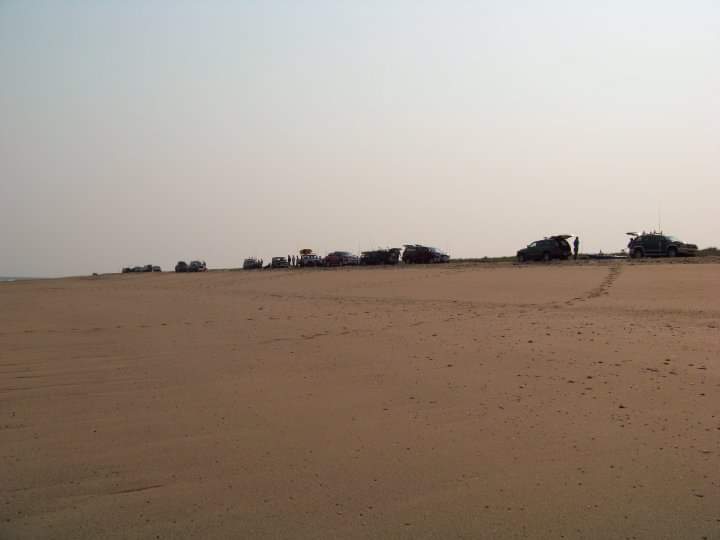Head to the Outer Cape
By Jared Wood

The fishing on Race Point can be electrifying at times. The last two weeks of May have been some of my favorite times to fish there. With the migration in full swing there can be droves of new fish hitting the surf everyday. The bite does change day in and day out but the days when a blitz happens it is a sight to see. The birds working, fish breaking, and fishermen dropping their coffee cups running down the sand with rod in hand. When the blitzes happen everyone on the beach joins in. It is a family atmosphere out there, everyone willing to help one another out.
Fishing the Race Memorial Day weekend 12 years ago. We had just driven onto the beach and the sun was just coming up. There were boats within casting distance and birds all over the water. I grabbed my rod and ran down to the water and fired my school bus Bomber into the surf. My plug hit the water and the surface erupted with bass breaking everywhere. A few turns of the handle and I am tight to a good fish. Next thing I know I am feeling my legs getting bumped while I am fighting my bass. I look down and I am surrounded by 20 and 30 pound stripers on the feed. They are banging me in the shins because the sand eels were taking up refuge around my legs. This went on for 6 hours that day. Those fish pushed two miles down the beach and then two miles back up the beach. There were kids having an absolute ball having never seen anything like that before in their lives. This was one of the wildest blitzes I had been a part of to this day.
There is access by foot for fishing the Outer Cape, but the best way to play the sands is by ORV. With a four wheel drive vehicle and the proper equipment you can obtain a permit at the Off Road Permit Station at Race Point Beach. Equipment needed for your dune buggy includes a shovel, tow strap 14 feet long, jack, jack support board (I use a 12”x12”x3/4” piece of plywood), tire pressure gauge, and full size spare tire. When driving on the sand you reduce your tire pressure to 12-15 psi allowing you to float over the sand and not dig in. Driving low and slow on the beach allows you control of your vehicle and keeps you from rutting up the ORV corridor.
Driving the beach allows you the ability to cover more ground at times. You are still going to have to do some walking to get where you want when the piping plovers have sections of the corridor closed when the chicks hatch. From your buggy you can cover ground looking for promising areas to fish. Looking for sandbars, troughs, rip lines, and cuts that expose themselves at different stages of the tide. Make a mental note or write it down in your logbook about the location of these areas so you can locate them when you come back later to fish it. To aid you in finding the location use landmarks, debris(logs, lobster pots, a cut in the dunes), or your vehicle odometer by resetting your trip odometer at the start of the trail letting you know how far you have gone.
Having all your gear in your buggy allows you to have back up plugs, line, leader, rods, motor oil, engine coolant, basic tools (wrenches/socket set), and a cooler for food and water. When you are that far out on the Cape there is not a tackle shop close by so making sure you have everything you need and then some is a must. Being prepared for tackle or vehicle breakdowns is a part of making sure you have a successful trip.
My Race plug bag in May is really simple. Having a Bomber Magnum Long A in School Bus is not a bad choice to have. A few pencils in white, yellow, and parrot are my main stays out on the sand. Race Point is not called sand eel city
for no reason. The abundance of sand eels is a fraction of what it was in years past but having a mix of soft plastics rigged on lead heads and weightless is a staple for fishing the shifting sands. Rounding out your plug bag with some metals, bucktails, needlefish, and a Danny plug or two will give you the tools to aid you in your pursuit. Out on the race a rod that can throw ¾-4 oz. in the 10 to 11 foot range will suit your needs pairing with a 5000 or 6000 size reel.
Even if you don’t catch any fish, the abundance of marine life that can be seen from shore is spectacular. The whales that cruise along can be seen almost daily. The ever growing seal population has made seeing multiple in a day a common occurrence. With the increase in the seal population there has been an increase in white shark activity. The chance of seeing a white shark hunting a seal is a possibility. The vast number of shore birds present allows for the opportunity for the budding photographer in you. When the fishing is slow, take in the wild landscape put before you.
Jared Wood is a surfcaster who fishes from Maine to Connecticut. Targeting Striped Bass, Bluefish, Albies, and Bonito in the surf. He can be found on instagram as surfcaster_jared. For any question he can be reached at jaredwood25@gmail.com.
